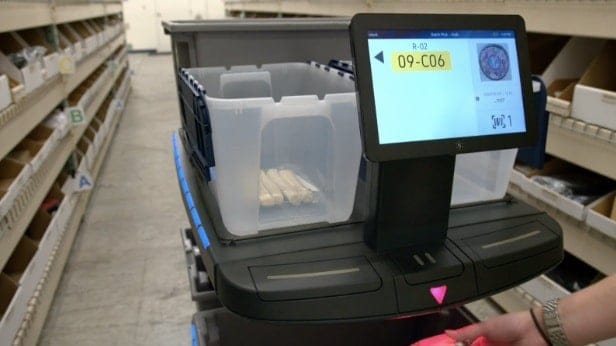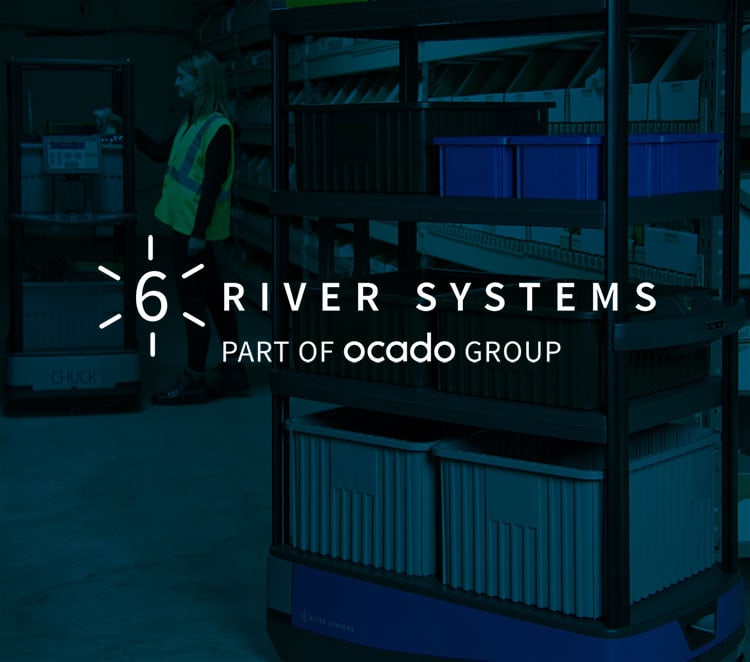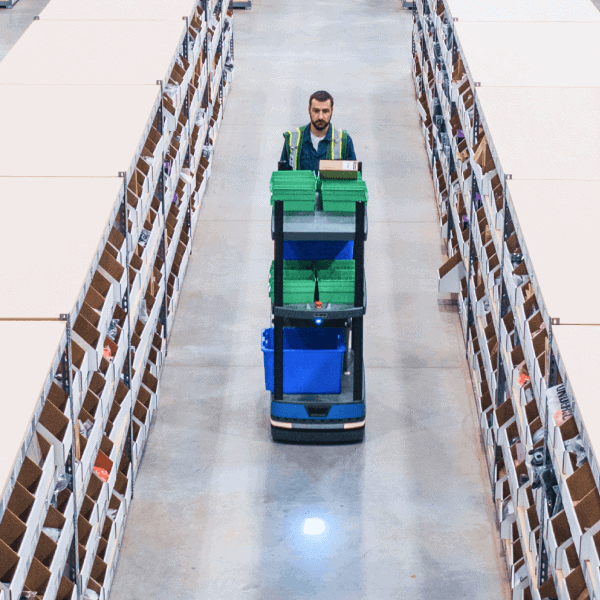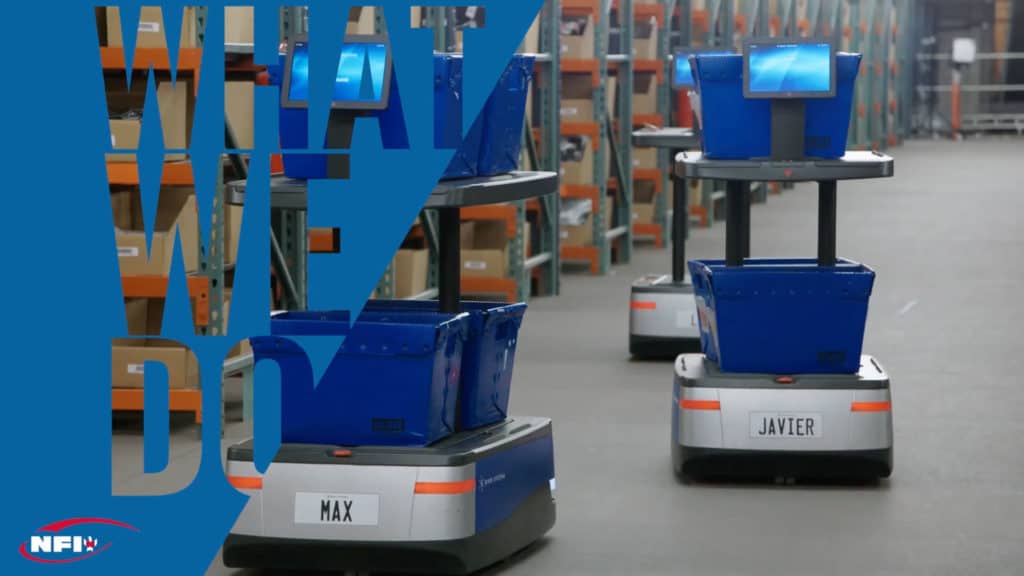More warehouses are adopting types of robotics technology than ever before. The warehouse robotics market was valued at $2.28 billion in 2016 and is expected to grow at a CAGR of 11.8% between 2017 and 2022, reaching $6 billion in value by 2022, with the U.S. market leading the way.
There are several types of warehouse robots in logistics offering varying functionality, allowing warehouses to select robotics solutions that aid with various processes. Warehouse operators should understand the available options to implement the right technologies to suit the warehouse’s needs. We’ve created this guide to provide an overview of the warehouse robotics market, the types of warehouse robots, their functions, use cases and other information warehouse operators need to know to make informed technology investments.
- Types of warehouse robots
- Industries that use warehouse robots
- How warehouse robots navigate the warehouse
- Uses for warehouse robots
Types of warehouse robots
The warehouse robotics industry includes several types of warehouse robots, serving a variety of purposes and functions such as order picking and moving inventory throughout the warehouse. Here’s a look at the various types of warehouse robots. 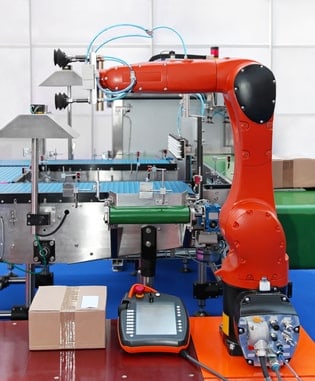
- Automated Storage and Retrieval Systems (AS/RS) — Automated storage and retrieval systems automate the inventory process by retrieving goods for shipment or use and returning items to their proper storage locations. AS/RS solutions include cranes that retrieve goods between aisles and shuttles that navigate between racks on a fixed tracking system.
- Goods-to-Person technology (G2P) — Similar to AS/RS, G2P technology includes goods-to-person picking robots that deliver items to picking stations, where operators are stationed to fill orders as items are delivered.
- Automated Guided Vehicles (AGVs) — AGVs, such as self-driving forklifts, transport inventory from one location to another within the warehouse. AGVs rely on tracks or magnetic strips placed in planned travel paths, sometimes paired with sensors or camera vision technology to avoid obstacles.
- Automated Guided Carts (AGCs) — AGCs and AGVs are sometimes grouped in the same category. The main difference is that AGCs carry smaller loads.
- Autonomous Mobile Robots (AMRs) — Autonomous mobile robots are similar to AGVs and AGCs in that they transport inventory and materials throughout a warehouse autonomously. Unlike AGCs and AGVs, which travel fixed routes guided by tracks or magnetic strips, AMRs rely on maps and sensors to navigate more flexible routes by interpreting the environment. Autonomous inventory robots are one type of autonomous mobile robots. When used with RFID-tagged equipment and items, autonomous inventory robots conduct inventory counts at pre-determined times or intervals. This category also includes collaborative mobile robots, which augment the work of humans by guiding associates through tasks.
- Articulated Robotic Arms — Robotic limbs with multiple joints and articulated robotic arms move and lift items in the warehouse. They’re typically used for receiving functions, such as moving items from pallets to racks, in production environments, for picking and packing and shipping.
- Unmanned Aerial Vehicles — Unmanned aerial vehicles, or unmanned autonomous vehicles (UAVs), commonly known as drones, provide real-time inventory visibility within warehouses when equipped with RFID technology.
Warehouse robots are also classified by payload capacity. Depending on the nature of the industry and the warehouse’s needs, warehouse robots with certain payload capacity are often used more frequently in some industries than others. Warehouse robots in the 0.5 kg to 10 kg (1.10231 lbs to 22.0462 lbs) range held the largest share of the warehouse robotics market in 2016 and is expected to grow at the highest rate during Market and Market’s 2017 to 2022 forecast period.
Industries that use warehouse robots

Warehouses spanning nearly every industry use warehouse robots, although warehouses in some industries rely on robotics more than those in other industries. Overall, growth in warehouse robotics adoption is driven by the “growing e-commerce industry, need for enhanced quality and reliability in warehouse operations, active funding from venture capitalists for startup robotics companies, and increasing adoption of warehouse robotics by small- and medium-sized enterprises (SMEs).” Markets & Markets predicts that the warehouse robotics market in the food and beverages industry will continue to grow at a high rate through the year 2022.
There’s also high demand for warehouse robots in the automotive industry, particularly the automotive spare parts sector. In contrast to the e-commerce food and beverages sector, automotive companies often invest in robots with heavier payload capacities to handle the spare parts that are too heavy for human workers to manage. By leveraging warehouse robots, automotive companies speed up the delivery of spare parts and increase their overall business productivity.
Other industries that use warehouse robots include:
- Electrical and electronics
- Metal and machinery
- Chemical, rubber and plastic
- Pharmaceuticals
- Apparel
- Textiles
- Paper and printing
How warehouse robots navigate the warehouse
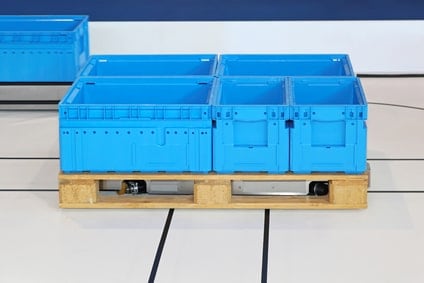
Warehouse robots rely on a variety of navigation systems to travel throughout the warehouse. Here’s a look at the most common navigation systems used by warehouse robots.
Rail navigation
Robots using rail-guided warehouse navigation systems travel along rails affixed in pre-defined routes on the warehouse floor.
Wire-guided navigation
Wire-guided navigation is similar to rail-guided navigation in that robots follow a physical guide — in this case, a wire rather than a rail — to navigate throughout the warehouse. The primary difference is rather than being affixed to the warehouse floor, the wires are located beneath the flooring. These robots have inductive sensors that measure the intensity of the electromagnetic field, created by a current flowing through the wire. One primary benefit of wire-guided navigation is that because the wires are hidden in the flooring, there’s no disruption to forklifts and other traffic that needs to travel over the area.
Magnetic tape-based navigation
Another navigation system based on a form of physical guidance, robots using magnetic tape-based navigation travel along pre-defined paths created by placing magnetic tape in desired routes. The tape creates an ambient magnetic field to guide robots.
Label-based navigation
For label-based navigation, robots are equipped with 3D laser range finders. Robots use data from the range finder to identify classes of objects such as shelves, doors and floors. Coupled with a global map of the environment, the robot’s positioning is determined based on object recognition. These robots can take orders based on semantic labels, such as the direction to “navigate to the closest door.”
Laser-based navigation
Several robot navigation systems make use of laser guidance in some form, such as label-based navigation, which uses 3D laser range finders for localization and object recognition. In other cases, robots rely on laser sensors entirely to create a three-dimensional map of the environment. These systems are typically coupled with algorithms in embedded processors or microcontrollers.
Vision-based navigation
Another form of navigation that makes use of laser sensors, vision-based navigation describes any navigation system using optical sensors such as laser-based range finders or photometric cameras with CCD arrays to interpret the visual features of the surrounding environment. This data is used for positioning and obstacle avoidance.
Geo-guidance
Robots using geo-guidance recognize their environment using sensors to establish their position within the warehouse based on a reference map, allowing it to identify objects such as racks, walls and pallets and determine their route.
LiDAR
LiDAR, which stands for Light Detection and Ranging, is a technologically advanced form of navigation used by 6 River Systems’ Chuck. Robots are equipped with LiDAR sensors that transmit a series of laser pulses to measure the distance from the robot to other objects in the environment. Compiling this data results in a complete, 360-degree map of the environment allowing robots to navigate throughout the facility and avoid obstacles without the use of any additional infrastructure. Using LiDAR coupled with machine learning and AI, Chuck plans the most efficient navigation routes in real-time.
Uses for warehouse robots
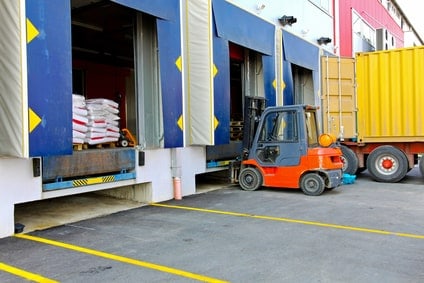
With advances in navigation technology and functional capabilities, warehouses use robots for a variety of applications today. Here’s a look at how warehouses make use of robots for common warehouse tasks.
Loading and unloading
Loading and unloading are processes typically carried out with the help of forklifts and pallet trucks, but AGVs like automated forklifts are helping warehouses speed up these tasks. While there’s a long way to go before warehouses fully realize automated loading and unloading, there are some robotics solutions that can perform tasks such as removing pallets from tractor trailers and placing them on conveyor belts or other systems for transport to sorting areas.
One shortcoming of current unloading robotics solutions is that modifications may be required to the back of tractor trailers — a costly and less-than-practical endeavor, especially for warehouses receiving goods from multiple logistics providers. In cases where modifications aren’t required, the process is slower.
Palletizing and depalletizing
Many warehouses use pallets to send and receive products, but palletizing and depalletizing are tedious, repetitive tasks. Although the concept of automated palletizing equipment isn’t new, it is growing in popularity, driven in part by a desire to reduce the strain on human workers resulting from tedious, non-ergonomically friendly tasks.
Typically, these solutions have an End-of-Arm Tool (EoAT) to grab items and position them on a pallet. They’re often paired with conveyors that feed products to the palletizing area. There are several types of robotic palletizing solutions, including bag palletizers and case palletizers, among others, and some can even handle fragile objects.
Sorting
Sorting seems like a straightforward process, but it’s actually a complex one to automate. Warehouse robots designed for sorting items must be able to pick up objects, identify and place them in the appropriate bin or other storage area. Warehouse sorting robots are often paired with conveyor systems and use some type of robotic arm to grasp objects, combined with cameras to “see” the item and algorithms to compare those images to other images for item identification. Robotic sorting solutions reduce the number of touches, transfers and conveyors needed compared to traditional sorting systems.
Picking
Picking accounted for the largest share of the overall warehouse robotics market in 2016, according to Markets & Markets. Given that labor costs comprise about 65% of a warehouse’s operations budget, it’s easy to see why warehouses are eager to adopt automation technologies that help human workers perform tasks more efficiently. Warehouses spanning a multitude of industries leverage picking robots, and for good reason: they are accurate, highly efficient and reduce order processing times and related order processing costs.
Robotic picking solutions like 6 River Systems’ Chuck rely on LiDAR for flexible navigation as well as machine learning and AI to determine the most efficient routes in real-time. Chuck enables associates to focus exclusively on picking by autonomously driving to and from active picking, induct and takeoff areas and leading associates through tasks. Another benefit is reduced walking time. One company, Healing Hands Scrubs, reduced associates’ walking time from 12 miles per day to just 3 miles per day after implementing 6 River Systems fulfillment solution.
Packaging
Packaging is another labor-intensive function in the warehouse that benefits from automated solutions. Automated packaging systems such as bagging machines help to speed up the packaging process. Cartonization software is another technology solution that calculates the ideal carton size for orders based on weight, dimensions and other data to reduce waste and cut down on labor costs by reducing the need to repackage orders.
Robots in Transportation
Robotic transportation systems take a number of forms, ranging from AGVs to conveyor systems and monorails. Monorails are typically used for pallet transport, while conveyors are used for transporting smaller items, boxes or bins. Some conveyors are capable of transporting pallets, as well. AGVs can be designed for customized load handling. These different robot solutions transport goods, containers or pallets from one location to another throughout the warehouse, such as from loading docks to sorting areas or from picking zones to packaging areas.
Storage
Automated storage and retrieval systems (AS/RS) include several types of warehouse robots, including pallet shuttles, mini-load systems and cranes. These solutions are sometimes used along with mobile racking systems to optimize space utilization. Typically rail-bound systems, AS/RS solutions are designed to work in tight spaces such as narrow aisles and great heights.
The average height of warehouses built in the U.S. grew to 33 feet in 2016, an increase from just 24 feet in the 1960s, and there’s a continued move upward toward 36-foot-clear warehouse facilities. The more cubic feet a warehouse can utilize, the more revenue potential they have. But storing and retrieving items located in the highest storage areas poses safety risks to human workers, and it’s also less efficient compared to storing or picking items located in more accessible areas. AS/RS allows warehouses to make more use of vertical space without sacrificing safety or efficiency. AS/RS solutions typically take up significant warehouse space, however, with a substantial investment in new infrastructure.
Delivery
Amazon and other major companies have their eye on types of autonomous delivery robots — namely, drones — but this technology isn’t yet ready for prime time. Autonomous vehicles are another possible innovation on the horizon, as well as variations on the concept such as driver-assisted vehicles. While warehouse robots haven’t transformed delivery processes just yet, this is an area to watch.
Replenishment
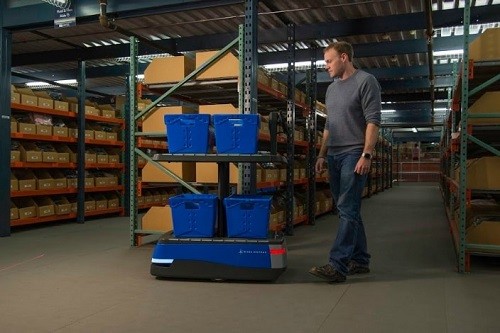
Using RFID to monitor inventory levels, drones scan barcode labels up to 50% faster than manual scanning and transmit inventory counts back to the warehouse management system. Configuring these solutions to issue alerts or assign tasks based on triggers, such as inventory counts dropping below a certain threshold, they can help to automate replenishment workflows. Some warehouse management systems can be configured to automate re-ordering, as well, reducing backorders and stockouts.
Additional resources on warehouse robots
Visit these resources to learn more about the warehousing industry and how warehouse robots are transforming every facet of warehouse operations:
- Warehousing and Logistics Robot Shipments Will Reach 620,000 Units Annually by 2021
- Bureau of Labor Statistics: Warehousing and Storage Industry At-a-Glance
- The trend towards warehouse automation
- 2018 Warehouse / Distribution Center Survey: Labor crunch driving automation
- GS1 US Survey Shows Manufacturers and Retailers Embrace RFID to Enhance Inventory Visibility
- A comparison of order picking methods augmented with weight checking error detection
- Robots Seem to Be Improving Productivity, Not Costing Jobs
- Global Warehouse Robotics Market Size and Forecast, by Product (Mobile, SCARA, Articulated), by Function, by Application (Packaging, Automotive, Pharmaceuticals, Food & Beverage), by Region, and Trend Analysis, 2015 – 2025
- Warehouse Robotics – Global Market Outlook (2017-2026)
- Other Voices: The robot revolution and five trends for 2019 and beyond
